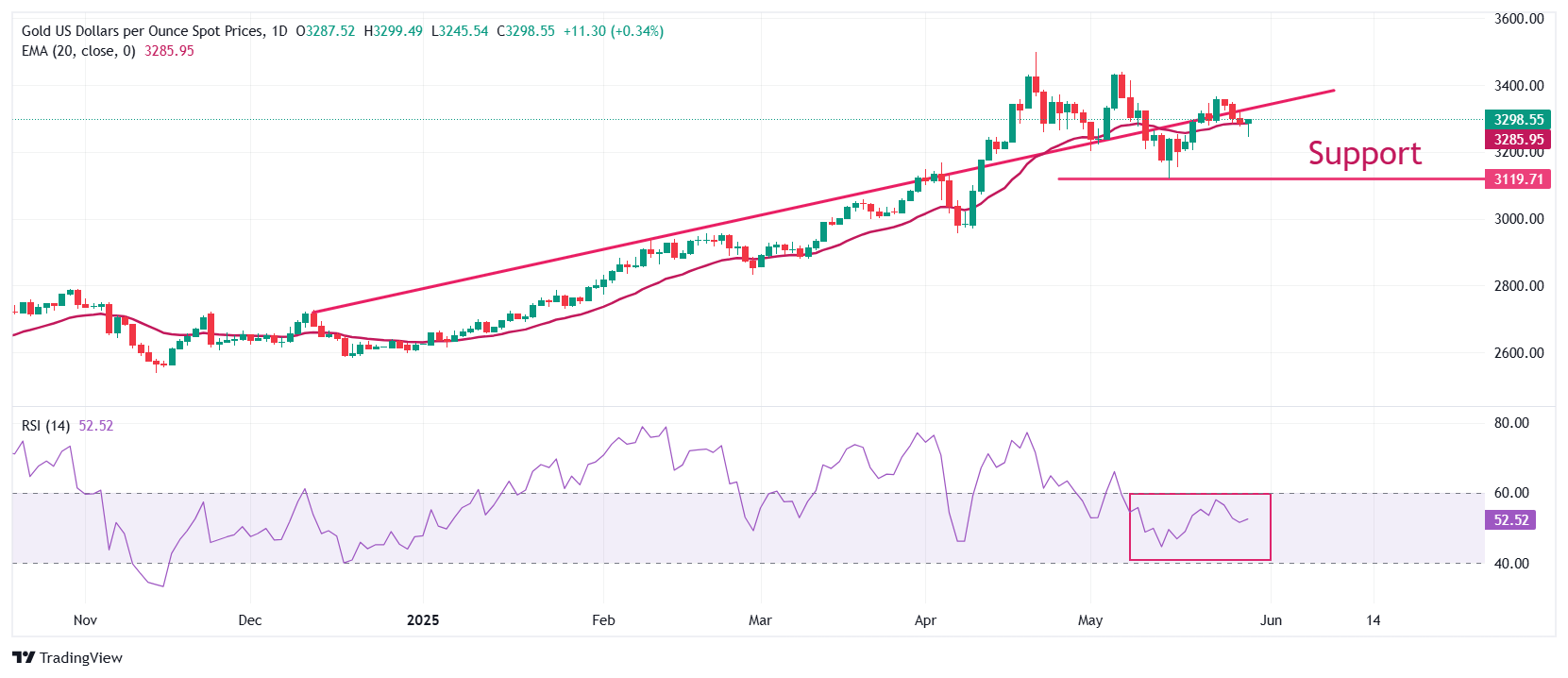Gold rebounds as US Dollar retreats while court strikes down Trump’s tariffs
- Gold price recovers its early losses as the US Dollar falls back, with the legal roadblock of Trump’s tariffs raising global economic uncertainty.
- The US court orders the administration to lift reciprocal import duties and tariffs related to fentanyl and immigration controls.
- US businesses are expected to suspend their investment plans before getting clarity on levies.
Gold price (XAU/USD) claws back the majority of its initial losses in Thursday’s European trading session, recovers to near $3,300 from the weekly low of $3,245 posted earlier in the day. The yellow metal bounces back as the US Dollar (USD) gives up its early gains in the aftermath of the legal roadblock on United States (US) President Donald Trump’s tariff policy.
The US Dollar Index (DXY), which tracks the Greenback’s value against six major currencies, surrenders initial gains and flattens slightly below 100.00 at the time of writing. Technically, a lower US Dollar makes the Gold price a value bet for investors.
On Wednesday, New York’s federal court accused US President Trump of violating the constitutional limit of the International Emergency Economic Powers Act (IEEPA) for fulfilling his tariff agenda, the Associated Press (AP) reported. The Manhattan-based court ordered the administration to lift import duties within ten days, to which the White House immediately appealed the decision.
In April, Trump announced reciprocal tariffs for all of his trading partners and additional duties on Canada, Mexico, and China for border negligence and pouring fentanyl into the US economy. He declared a national emergency under the IEEPA to justify levies. This suggests that the imposition of tariffs by Trump on automobiles, steel, aluminum, and semiconductors remains intact.
Daily digest market movers: Gold price recovers initial losses
- The US court blocking Trump’s tariffs came as relief for financial market participants who were cautious over the economic outlook, assuming that new international policies would be stagflationary for the economy. This led to a sharp decline in the demand for US bonds, which spiked 10-year US Treasury yields over 1% to above 4.53%, lifting demand for the US Dollar and US equity futures.
- However, the US Dollar is off from its day’s high as the event has renewed concerns over its credibility. The stop-and-go announcements on levies are expected to force domestic companies to revise their business plans, which were designed considering the import duty policy as the new normal. Businesses had started preparing investment plans to boost domestic manufacturing.
- US President Trump stated numerous times that his campaign to bring manufacturing back to the nation will be beneficial for the labor market. Last week, he also threatened to impose 25% tariffs on smartphone makers for not producing them in the US.
- "My big worry is that companies start to put off things like hiring or capital expense or giving people raises for these factories or manufacturing," according to analysts at Invesco. They added that the event could certainly put a “damper on company earnings” and “consumption could also be impacted”.
- On the economic front, investors await the US Personal Consumption Expenditure Price Index (PCE) data for April, which will be released on Friday. The US core PCE inflation data, which is the Federal Reserve’s (Fed) preferred inflation gauge, is expected to have grown at a moderate pace of 2.5% on year, compared to the prior release of 2.6%. The impact of the inflation data is expected to be limited on the Fed’s monetary policy outlook as the US court striking down Trump’s tariffs has heightened uncertainty over economic prospects.
Technical Analysis: Gold price wobbles around the 20-day EMA

Gold price recoups early losses but continues to struggle around the upward-sloping trendline on a daily timeframe around $3,335, which is plotted from the December 12 high of $2,726. The near-term trend of the precious metal is uncertain as it wobbles around the 20-day Exponential Moving Average (EMA), which trades near $3,286.
The 14-day Relative Strength Index (RSI) oscillates inside the 40.00-60.00 range, suggesting indecisiveness among market participants.
Looking up, the May 7 high around $3,440 will act as key resistance for the metal. On the downside, the May 15 low at $3,120.83 will be the key support zone.
Gold FAQs
Gold has played a key role in human’s history as it has been widely used as a store of value and medium of exchange. Currently, apart from its shine and usage for jewelry, the precious metal is widely seen as a safe-haven asset, meaning that it is considered a good investment during turbulent times. Gold is also widely seen as a hedge against inflation and against depreciating currencies as it doesn’t rely on any specific issuer or government.
Central banks are the biggest Gold holders. In their aim to support their currencies in turbulent times, central banks tend to diversify their reserves and buy Gold to improve the perceived strength of the economy and the currency. High Gold reserves can be a source of trust for a country’s solvency. Central banks added 1,136 tonnes of Gold worth around $70 billion to their reserves in 2022, according to data from the World Gold Council. This is the highest yearly purchase since records began. Central banks from emerging economies such as China, India and Turkey are quickly increasing their Gold reserves.
Gold has an inverse correlation with the US Dollar and US Treasuries, which are both major reserve and safe-haven assets. When the Dollar depreciates, Gold tends to rise, enabling investors and central banks to diversify their assets in turbulent times. Gold is also inversely correlated with risk assets. A rally in the stock market tends to weaken Gold price, while sell-offs in riskier markets tend to favor the precious metal.
The price can move due to a wide range of factors. Geopolitical instability or fears of a deep recession can quickly make Gold price escalate due to its safe-haven status. As a yield-less asset, Gold tends to rise with lower interest rates, while higher cost of money usually weighs down on the yellow metal. Still, most moves depend on how the US Dollar (USD) behaves as the asset is priced in dollars (XAU/USD). A strong Dollar tends to keep the price of Gold controlled, whereas a weaker Dollar is likely to push Gold prices up.


